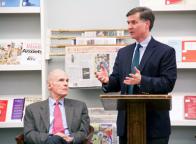On the morning of Monday, February 3, Daniel Esty wrapped up his three-year term as Commissioner of the Connecticut Department of Energy and Environmental Protection (DEEP). That evening, he arrived at NYU School of Law, where Professor Richard Stewart, director of the Frank J. Guarini Center on Environmental and Land Use Law, welcomed him for his first post-DEEP talk.
Esty’s lecture conveyed the practiced capability and finesse needed to gather bipartisan support for an innovative environmental strategy. His manner was in utter contrast to what he described as today’s national failure: the “very fundamental breakdown in Washington when it comes to energy policy, climate change policy, [and] environmental policy.” He described a stagnant federal government that has moved little on the environment since the United Nations Framework Convention on Climate Change treaty of 1992.
In response to Washington’s foot-dragging, he and Governor Dannel Malloy pushed for fresh thinking at the state level. DEEP, Esty said, is better spelled “DEEEP”—energy, environment, and economy. It’s the “triple E agenda.”
“You cannot pursue a clean energy agenda without simultaneously pursuing cheaper and more reliable energy,” he argued. That is, people are far likelier to support clean energy if it’s easy to finance and cheaper than fossil fuels.
So, among his goals was “normalizing” clean energy—making it normal for people to invest in clean energy projects. This means standard forms and checkpoints. It also means that Connecticut’s “green bank”—the Clean Energy Finance and Investment Authority—now helps “de-risk” investments in clean energy projects. Created in 2011, it can take the first 2% of defaults on clean energy investments, encouraging banks to make loans for such projects at lower interest rates.
This initiative has already impacted New York: in 2013, Governor Andrew Cuomo set up the New York Green Bank, a division of the New York State Energy and Research and Development Authority, with an initial $210 million funding.
In Connecut, the green bank, combined with other practices like long-term contracts and reverse-auctions, has meant the following: Esty said that when he took over, Connecticut was paying about 40 cents per kilowatt-hour of solar power. Since then, they’ve pushed that price down to 15 cents per kilowatt-hour; on grid-scale projects in New England, he said the cost is under eight cents per kilowatt-hour.
“That is grid-scale parity,” he concluded. “And by the way, in my mind, that’s the end to the climate-change challenge: It’s not a big treaty, it’s not a Waxman-Markey big cap and trade bill. It is simply a driving of innovation through the series of innovation steps, so that the price of renewable energy comes in under the price of the fossil fuel status quo.” If clean energy is cheaper, people will adopt it, period. “That’s the 21st century model that I propose to you tonight.”
Esty served as commissioner while on a public-service leave from Yale University, where he is the Hillhouse Professor of Environmental Law and Policy in the School of Forestry & Environmental Studies, and Clinical Professor of Environmental Law and Policy at Yale Law School. He is also director of both the Yale Center for Environmental Law and Policy and the Center for Business and the Environment. These roles are a testament to a career dedicated to the environment.
In his resignation letter, Esty wrote of his experience, “As a boy spending the day at Black Rock State Park, I never could have imagined that I would have the opportunity to lead the agency so central to protecting that park as well as Long Island, and all of the other parks, forests, rivers, and lakes that make Connecticut a special place to live and work.”
After three years of dedication, he was able to offer Connecticut as a hopeful example, a “model for how an energy agenda moves state by state perhaps. Maybe someday nationally.”
Watch the video below of Daniel Esty’s lecture (1 hr):
Posted on February 10, 2014
